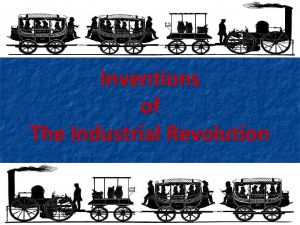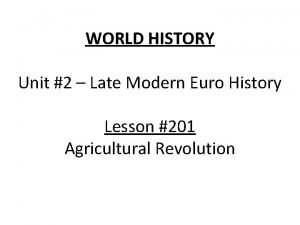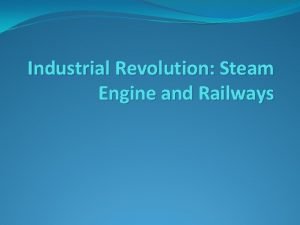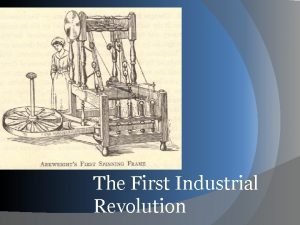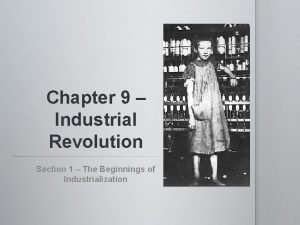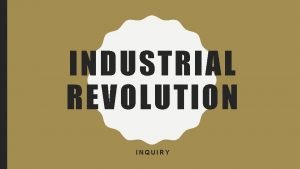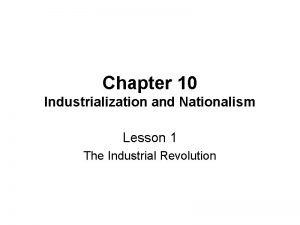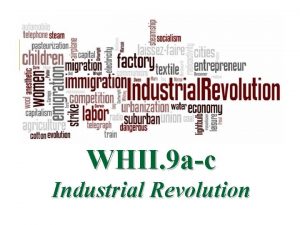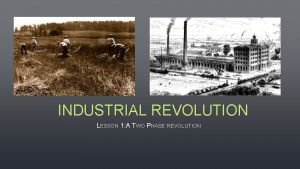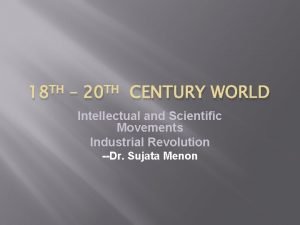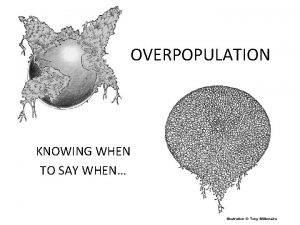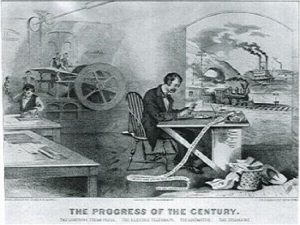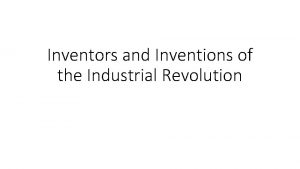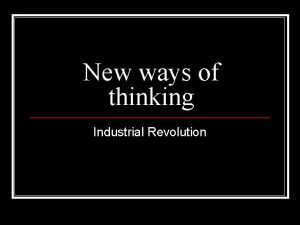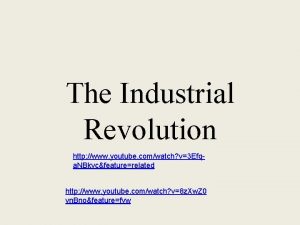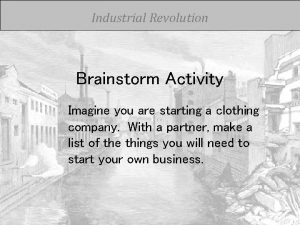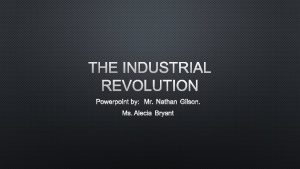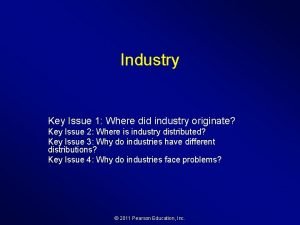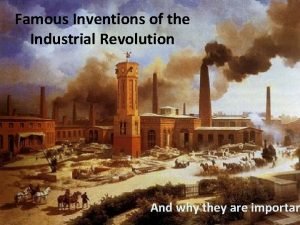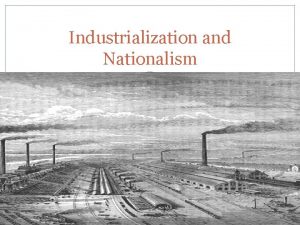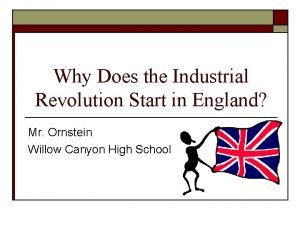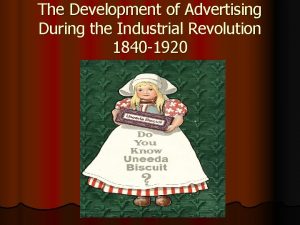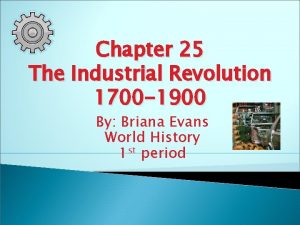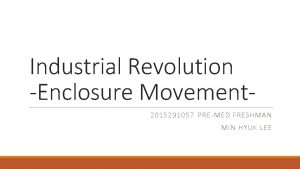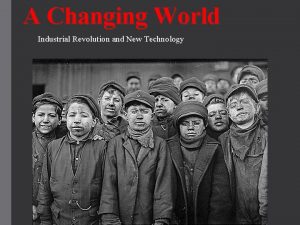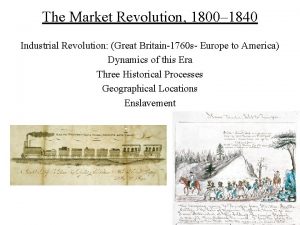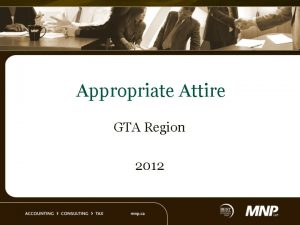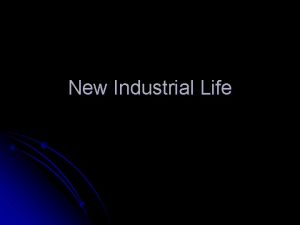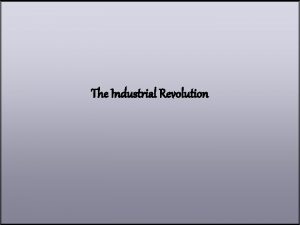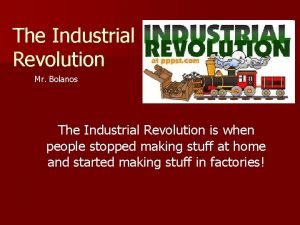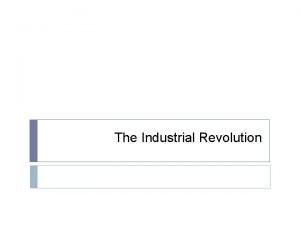The Industrial Revolution The Industrial Revolution less appropriate







































- Slides: 39

The Industrial Revolution

The Industrial Revolution (less appropriate title slide)

Defining the IR l l l Name given in late 1800 s to describe the historical period beginning in 1750 in England. Machines replaced animal and human labor in production and distribution of goods Initially subtle, but by 1850, changes were allencompassing

Causes of the IR l l Commercial Revolution of 1500 -1700 triggered economic growth following exploration, colonization, and mercantilism Inventions of the Scientific Revolution Population increases in Europe (140 million to 266 million from 1750 to 1850! Political and social revolutions of the 19 th century l l Rise of the middle class General interest in economic change and financial gain

Development and Spread of IR l Development l l Agricultural revolution frees laborers for cities Cotton and metallurgy changes 18 th century inventions lead to mechanized production of textiles Use of coal over wood as fuel l l Changes in mining Steam engine Locomotive Steam power develops as an alternative to run textile and iron industry Transportation revolution l Spread l l l West to east/north to south Latecomers learned from those earlier on the scene Depended on available labor and coal and iron deposits England led the way through the 1800 s By late 1800 s Germany surpassed England

Overall Effects l l l l End of the 3 estates Strengthened bourgeoisie Money=power Dehumanization of wage earning factory workers Urbanization of the world l Factory’s magnet effect: pulls populations l Transformation of city from cultural and political center to industrial center Working class strives for collective power Family as an economic unit no more: consumers not producers! Changes in family structure l Working outside home l Women relegated to domestic sphere l Increased wage-earning opportunities for single women l Child labor

The IR in England: Why? MAGIC! l M arkets abroad l l l A gricultural Revolution l l l Lager population from increased food supply Relocation of population to urban centers after enclosure G overnment protects of private property/entrepreneurs l l Many colonies for raw materials and to sell finished products Maritime strength to protect them! Bourgeoisie in parliament Government supports risk I ron and Coal deposits C apital l People had $ after commercialization These people were willing to make risky investments National bank

Technological Changes and New Forms of Industrial Organization – The Cotton Industry l l l Cottage/putting out system was the beginning… FLYING SHUTTLE allowed weaving output to double! Hargreaves’ SPINNING JENNY was perfected in 1768 to allow for rapid yarn production Arkwright’s WATER FRAME and Crompton’s MULE further boosted yarn production until yarn outdid weaving again… Cartwright’s POWER LOOM (1787) allowed weaving to catch up again. Despite these inventions, HAND LOOMS continued to dominate – at least until mid-1820’s. l l l Between 1813 and 1850, # of power looms jumped from 2400 to 250 k! Conversely, number of hand looms fell 250 k to 3000 from 1820 to 1860. Easier to bring workers to machines than vice versa, and factories sprang up near water supplies for power and towns grew around them.

Technological Changes and New Forms of Industrial Organization – Steam Power l l l l Grew from mining demands for coal as an alternative energy source to timber, which was facing shortage. Machines needed to prevent water seepage into deep coal mines. Newcomen’s ATMOSPHERIC ENGINE or steam pump was developed in 1712, but it was inefficient. Watt’s STEAM ENGINE came to replace this model – quite by mistake – as he was originally charged with repairing a Newcomen engine… Eventually, a more energy efficient model was developed and Watt adapted it to the textile mills, triggering massive textile production. In 1800, English engines produced 10 k horsepower by 1850, 500 k in stationary engines and 790 k in mobile engines such as locomotive. “Steam is an Englishman” (1850).

Technological Changes and New Forms of Industrial Organization – Iron Industry l l GB had HUGE deposits of iron, but no efficient way of refining 1780, Henry Cort’s PUDDLING process used coal power to make a more pure form of iron. Iron production soared – fueled in part for a demand to make the new machines of iron! BY 1852, GB produced more iron than the rest of the world combined! 3 mil tons!

Transportation Revolution? l l l Roads and canals built between 1760 and 1830 greatly improved trade within the state, but RRs soon overtook them in importance. RR had origins in mining operations in Germany where wood rails were used to guide carts and reduce friction in large loads so horses could pull more. Wood rails replaced by iron ones, and then horses replaced by steampowered engines! Stephenson’s ROCKET was the most efficient eventually able to travel about 50 mph. GB’s railways reflected the change, as there were 2 k miles of track in 1840, but 6 k by 1850. RR construction created thousands of jobs for displaced farm workers and peasants who could flock to factories.

The Factory System l l l New patterns of production brought hundreds of workers out of their homes and workshops and into large-scale factories to run machines. To maximize profits, machines had to be going all the time, creating a need for regular shifts at the factories. Workers now had to work constantly, consistently and efficiently, or face harsh consequences from being docked pay to enduring beatings to dismissal. Work was boring and tedious, so it was difficult to stay engaged. Laziness, tardiness and drunkenness were not tolerated, though they certainly occurred with regularity. Eventually, after 2 -3 generations, regular hours viewed as typical.

The Great Exhibition: Britain in 1851 l l l Great Exhibition heralded by Prince Albert to display Britain’s wealth GB had organized the first industrial fair in 1851 at Kensington in London in the Crystal Palace, which was made especially for the event. l Palace was made of glass and steel as a testament to Brit engineering superiority. l Covered 19 acres, housing 100, 000 exhibits! l Even featured a tree inside, symbolic of man’s domination over nature 6 million people visited the exhibition over a 6 month period – traveling from other areas in GB or from around the world. England had indeed become the “workshop, banker and trader of the world. ” Produced half of world’s coal and manufactured goods.

The Crystal Palace (1851)

© 2003 Wadsworth, a division of Thomson Learning, Inc. Thomson Learning™ is a trademark used herein under license. The Industrial Revolution in Britain

The Spread of Industrialization l l First areas on the continent to be industrialized: Belgium, France, and the German states. Generally, industrialization moved west to east, north to south in Europe. In North America, the US became industrialized. All other areas had to wait until after 1850.

The Spread of Industrialization l Despite achieving population growth, agricultural reform, expansion of cottage industries and increased foreign trade, continental countries did NOT have all the advantages England did and lagged behind. l l Poor roadways and river tolls hindered transportation of raw materials/finished products. Guild control over industries Investors unwilling to make risky investments French revolution/Napoleonic Wars destroyed trade networks and decimated the working population

The Spread of Industrialization l Separation of GB from the continent eventually put continent at a disadvantage in terms of having access to machinery l l Brits were resistant to sharing their secrets! Some Brits took their know-how to the continent made a financial killing with their new technology l exploited the less knowledgeable continental industries l l Some continent dwellers resented British snobbery

The Spread of Industrialization l Eventually, continent dwellers learned the tricks of the trade l l l established technical schools (esp. German states) to train engineers and mechanics. Governments in these areas sponsored grants for investors and encouraged people to enroll in these schools. Joint-Stock investment banks in Belgium, German states and in France helped to finance the fledgling industries l l l Societe General and Banque de Belgique in Belgium Credit Mobilier in France Darmstadt Bank in Germany Kreditanstalt in Austria. After Napoleon’s defeat in 1815, GB flooded continent w/cheap goods and fledgling industries on continent couldn’t compete. Protective tariffs helped to protect nations’ new industries, as outlined by Friedrich List in his National System of Political Economy.

Emerging Centers Industrialization l l l German states, Belgium and France led the way. Industrial centers more widely dispersed than in England. In textile industry, a mix of old and new technology coexisted. Iron and coal of heavy industry drove the IR on the continent. By 1850, a GB would lose its position as industrial leader of the world to Germany.

© 2003 Wadsworth, a division of Thomson Learning, Inc. Thomson Learning™ is a trademark used herein under license. Industrialization of Europe by 1850

Social Impact of Industrialization: Population l l HUGE INCREASE IN POPULATION AT THIS TIME – WHY? l Record keeping more accurate l Fewer famines, epidemics, and wars l Larger supply of food – people ate better, thrived, bred POPULATION composition changed l How people were concentrated changed l many more involved in industrial sector – up to 48% in GB l confined to tiny areas of a nation. l Lots of congestion even in countryside – booming population and not a whole lot of land to go around. l Ireland was a prime example. l Thanks to potato, population doubled 1781 -1845 from 4 -8 million l Potato blight of 1845 decimated the food supply l Great Famine: 1845 -1851… death and emigration l Irish weren’t the only ones leaving Europe. About 110 k per year between 1821 -1850 fled for greener pastures – or for urban areas.

Social Impact of Industrialization: Urbanization l l Massive population boom in CITIES caused a number of changes demographically People went to find jobs around industrial towns These towns grew rapidly – and with little “urban planning” Urban Living Conditions in the Early Industrial Revolution l l l Sanitary conditions Cholera Suburbs Row houses Adulteration of food Moral consequences of urban life

Social Impact of Industrialization: Slums Slum housing in the industrial revolution

Urban Living Conditions & Reforms l 1820 s efforts in France and Britain did exist to improve cities l l Some reformers regarded the lower levels of society with contempt James Kay-Shuttleworth: people lived like “brutes” who “eat, drink, breed, and die” British Poor law Commission attempted to report on these horrid conditions. Edwin Chadwick (1800 -1890) Secretary to Poor Law Commission l Report on the Condition of the Labouring Population of Great Britain in 1842 l Use of drainage l Piped water l 1848: GB had 1 st Public Health Act created a National Board of Health to “clean up” cities Elizabeth Gaskell’s Mary Barton

Urban Living Conditions & Reforms Shuttleworth and Chadwick

New Classes l l Industrial Middle Class l The new bourgeoisie meant industrialists, professionals and government officials whose drive was to GET MONEY! l Many got rich through risky investments as entrepreneurs l Some entrepreneurs came from lowly backgrounds, some from ranks of aristocracy! l These people bought great estates and liked to show off that they had “made it” Working Class l Comprised of laborers in agriculture, but increasingly people who worked in cities in industry or as servants. l Artisans fought industrialization l Regarded as lowlife by bourgeoisie

Working Conditions for the Industrial Working Class l HEINOUS! l l l l 14 hour days locked up without windows, ventilation, heat Mills were dusty, dirty, nasty Mines experienced cave-ins regularly – gas fumes killed thousands and deformed bodies and ruined lungs resulted. Women and children often exploited as a work force – 1/3 to 1/6 cost, and were smaller to dive into moving machine parts! Pauper Apprentices were kids who were orphaned and abandoned to local factory owners as a cheap labor source. By 1830 women and children made up 66% of labor supply in cotton industry but passage of Factory Act of 1833 changed number of kids. This changed focus to men as primary wage earners. In 1844 and 1867 hours were also regulated and rescaled.

Working Conditions for the Industrial Working Class Children and women being exploited during early industrial movement.

Working Conditions for the Industrial Working Class l Standards of Living l l l Fluctuations of wages and prices Consumption Periodic overproduction and unemployment

Efforts at Change l Unionizing Efforts l l l Many nations outlawed formation of workers unions – e. g. Combination Acts of 1799 in GB said NO WORKERS ASSOCIATIONS Many unions and associations formed anyway l strikes in Glasgow and Manchester l Government forced to repeal Combination Acts in 1824. l Unions were tolerated but closely monitored. Robert Owen (1771 -1858), l Utopian Socialism - cooperative methods rather than competitive l Grand National Consolidated Trades Union (est. 1834) goal of establishing an 8 hour work day

Efforts at Change l l Luddites in England attacked machines in protest of industrialization (1812) Chartist Movement l Emerged to achieve political democracy for working class folks. l Drew up People’s Charter in 1838 to demand universal suffrage. l Chartist petitions in 1839 and 1842 were both “DIE, Demon-Beotch Machine, DIE!!!” rejected by parliament.

Chartist Demands – In Short

Efforts at Change l Efforts at Change: Reformers and Government l Factory Acts 1802 and 1819 l l l Factory Act of 1833 l l l l limited labor hours for kids between 9 -16 to 12 hours a day kids under 9 couldn’t work Followed Sadler Commission Report (1832) by Michael Sadler who interviewed child laborers and revealed their mistreatment (see primary source reading) kids 9 -13 only could work 8 hour days those aged 13 -18 could only work 12 hours Inspectors brought in to enforce laws Required kids 9 -13 have 2 hours of elementary education a day Ten Hours Act of 1847 reduced work day for kids to 10 hours aged 13 -18 Coal Mines Act of 1842 eliminated employment of boys under 10 and women in mines Corn Laws, 1815 (repeal, 1846) Peterloo Massacre, 1819 l l Named b/c of Waterloo but took place at St. Peter’s Fields in Manchester. Cavalry charged into 80 k demonstrators rallying for parliamentary representation (rotten boroughs)

Economists’ Viewpoints: The Capitalists l l Adam Smith’s Wealth of Nations Samuel Smiles l l l l Self Help (1859) and Thrift (1875) advocate CAPITALISM and working for social and intellectual development of the working classes to promote their success. Upward mobility for the lower classes was possible through hard work, competition, and diligence. TIME IS MONEY!! Work with BODY AND BRAIN. Plan for the future: Save your wages, Support your family! Translated into many languages – including Japanese!

Economists’ Viewpoints: The Capitalists l Thomas Malthus l l l Essay on Population (1826) Population increases geometrically; subsistence, only arithmetically. Nothing can be done to help the lot of the working class. It’s inevitable they will be poor. David Ricardo l l Principles of Political Economy and Taxation (1817) IRON LAW OF WAGES: l Natural wage is at subsistence level. l Pay worker JUST ENOUGH to get by, or they will breed and lower their own wages, decrease their standards of living in the end and plague society.

Economists’ Viewpoints: Critics of Capitalism l l l Jeremy Bentham and Utilitarianism l Greatest good for the greatest number. l Government should regulate the abuses of capitalism l HOWEVER, generally, individual knows best how to safeguard general welfare. Charles Dickens l Hard Times l awful plight of the working class in England. Marx and Engels l Condition of the Working Class in England (1845) Communist Manifesto (1848) l Capitalism is simply the final stage before the proletariat (working class) revolt against the exploitation of the bourgeoisie (capitalist) class. l Class conflict inevitable and classless society will triumph! l Surplus Value belongs to the worker!

Discussion Questions l l What were the factors, or conditions, that gave Britain the edge in the Industrial Revolution? How do you see the old adage “necessity is the mother of invention” played out in the early industrial revolution in England? How is transportation changed in England as a result of the Industrial Revolution? Why does England see Germany as a threat but not the United States?

Web Links l l l l Industrial Revolution in Britain James Watt Richard Trevithick Great Exhibition of 1851 Edwin Chadwick Robert Owen Chartism
 Greek and roman art similarities
Greek and roman art similarities Russian revolution vs french revolution
Russian revolution vs french revolution Economic causes of french revolution
Economic causes of french revolution Modern commercial agriculture
Modern commercial agriculture Phonograph industrial revolution
Phonograph industrial revolution Enclosure movement industrial revolution
Enclosure movement industrial revolution Beam engine application
Beam engine application Water frame significance
Water frame significance The tyger industrial revolution
The tyger industrial revolution Industrial revolution crime
Industrial revolution crime Chapter 9 the industrial revolution
Chapter 9 the industrial revolution Industrial revolution inquiry questions
Industrial revolution inquiry questions Industrialization and nationalism lesson 1
Industrialization and nationalism lesson 1 Industrial revolution
Industrial revolution Enclosure movement industrial revolution
Enclosure movement industrial revolution Lesson 1 the industrial revolution
Lesson 1 the industrial revolution 4th industrial revolution
4th industrial revolution Entrepreneurs industrial revolution
Entrepreneurs industrial revolution How did classical liberalism help the industrial revolution
How did classical liberalism help the industrial revolution Phonograph industrial revolution description
Phonograph industrial revolution description Thomas malthus industrial revolution
Thomas malthus industrial revolution Syncretism definition ap human geography
Syncretism definition ap human geography Industrial revolution natural resources
Industrial revolution natural resources Industrial revolution inventors and inventions
Industrial revolution inventors and inventions Laissez faire industrial revolution
Laissez faire industrial revolution Enclosure movement definition industrial revolution
Enclosure movement definition industrial revolution Hurriers industrial revolution
Hurriers industrial revolution Industrial revolution powerpoint
Industrial revolution powerpoint Negative effects of the industrial revolution
Negative effects of the industrial revolution Spread of the industrial revolution map
Spread of the industrial revolution map Famous inventions of the industrial revolution
Famous inventions of the industrial revolution Chapter 10 lesson 1 the industrial revolution
Chapter 10 lesson 1 the industrial revolution Why did the industrial revolution start in britain
Why did the industrial revolution start in britain Industrial revolution ad
Industrial revolution ad The tyger literary devices
The tyger literary devices Chapter 25 the industrial revolution
Chapter 25 the industrial revolution Enclosure industrial revolution
Enclosure industrial revolution Smallpox vaccine description industrial revolution
Smallpox vaccine description industrial revolution Industrial worker
Industrial worker Long term impacts of the industrial revolution
Long term impacts of the industrial revolution




